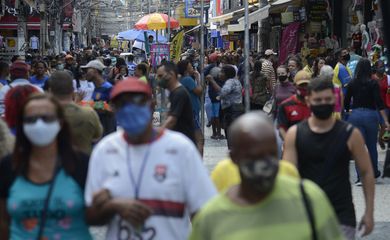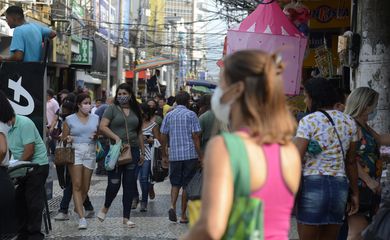IBGE: unemployment drops 1.6% and reaches 12.6% in the first quarter
Invalid Scald ID.
The unemployment rate reached 12.6% in the third quarter of this year, which means a drop of 1.6 percentage points compared to the second quarter of 2021. The number of people looking for a job in the country dropped 9.3% and , with that, reached 13.5 million. The employed grew by 4%, reaching 93 million people. Data from the Continuous National Household Sample Survey (PNAD Continuous), were released today (30) by the Brazilian Institute of Geography and Statistics (IBGE).

For IBGE's Work and Income coordinator, Adriana Beringuy, the growth in occupation in the period was relevant. “In the third quarter, there was a significant process of growth in occupation, which even allowed for a reduction in the unemployed population, who are looking for work, as well as the population that was out of the workforce”, he observed.
The population outside the labor force is the contingent of those who are neither employed nor looking for a job. With the growth in the number of employed persons, the level of employment, which is the percentage of people of working age who are in the labor market, rose to 54.1%, compared to 52.1% in the previous quarter.
Domestic
According to the coordinator, within this growth, informality represents 54%. Employees of the private sector without a formal contract (10.2%), which added up to 11.7 million people, are among the employment categories that grew the most in comparison with the previous quarter. In the same period, the number of domestic workers reached 5.4 million - which is equivalent to an expansion of 9.2%, the highest since the beginning of the historical series of the survey, in 2012.
In the first quarter of last year, six million people were domestic workers. If only unregistered workers are considered, there was an increase of 10.8%, with 396 thousand more people.
According to Adriana Beringuy, this is a recovery process that has been taking place since June. “The category of domestic workers was the most affected in the occupation last year and, in recent months, there has been an important expansion. Although there is this recovery in the last quarters of the survey, the current contingent of these workers is lower than the pre-pandemic period”, he stated.
own account
The number of self-employed workers (3.3%) also increased. The 25.5 million people in this category represent the largest number since the beginning of the survey's historical series. This includes workers who do not have CNPJ, which grew 1.9% compared to the last quarter. With that, the informality rate reached 40.6% of the population. There are 38 million workers in this situation.
According to the survey, the growth in occupation is also mainly related to trade activities (7.5%), which is equivalent to over 1.2 million workers; industry (6.3%), 721 thousand more people; construction (7.3%) with 486 thousand more people; and domestic services (8.9%), with the addition of 444 thousand people.
Performance
The advance in the number of employed people did not come with improvements in the usual real income of all jobs. It was R$2,459, down 4% from the last quarter and 11.1% from the third quarter of last year.
With the value of R$223.5 billion, the income mass was stable in both comparisons. For the coordinator, these numbers indicate that the increase in occupation was driven by jobs with lower salaries. “There is a growth in occupations with lower incomes and there is also a loss of purchasing power due to the advance of inflation”, he added.
Regions
The drop in the country's unemployment rate extended to all regions. In the Southeast, which is the region with the highest number of unemployed people (6.3 million), the rate rose from 14.6% in the second quarter to 13.1%. In the Northeast, it went from 18.3% to 16.4%. Even so, the region still has the highest unemployment rate in the country.
“This drop in unemployment at the national level is also being observed regionally in several states. This indicates that there is a work recovery process that is taking place in a widespread manner in the country”, he said.
Even with the highest unemployment rate in the country (18.7%), Bahia showed stability in this indicator and in the number of people looking for a job in the labor market (1.3 million). The number of employed persons in the state grew 6.5%. The reason was the increase in domestic workers (18.3%) and self-employed (12.3%). According to the survey, after Bahia, the highest unemployment rates were registered by Amapá (17.5%) and Rio Grande do Norte (14.5%).
Among the 93 million employed people in Brazil, after a 4.0% increase in the third quarter, 66.4% of employees, 4.1% of employers, 2.1% of auxiliary family workers and 27.4% of people who were self-employed. This last group was larger in the North (34.5%) and in the Northeast (31.1%). According to the survey, of the 17 states that had rates of informality higher than the national figure, 16 are in the North and Northeast. Pará (62.2%) registered the highest.
The IBGE's Work and Income coordinator said that these regions, in general, have a large percentage of this type of work. “Informality is greater in these two regions. And this worker profile is contributing to the recovery of local work. An important part of the work in these two regions is attributed to informal workers, who have a large number of self-employed workers”, he concluded.
black and brown
While the unemployment rate of white people (10.3%) was below the national average, that of blacks (15.8%) and browns (14.2%) had the opposite trend. All had a fall compared to the last quarter. Browns represented 46.8% of the population outside the workforce, followed by whites (43.1%) and blacks (8.9%). Compared to the second quarter, the participation of browns decreased and that of whites and blacks increased.
In comparison with the third quarter of last year, the level of occupation increased for all people. Whites went from 51.4% to 55.8%, browns, from 46.7 to 52.1%, and blacks, from 49.0% to 55.6%.
reweighting
Today's release of Pnad Contínua is based on the new series prepared by the IBGE, based on the reweighting of projections due to the change in the way research was collected during the covid-19 pandemic. With the social isolation measures in March 2020, the collection began to be done remotely, exceptionally by telephone.
"The new reweighting seeks to mitigate possible availability biases in population groups, intensified by the drop in the rate of use of interviews", noted Adriana.
Search
According to IBGE, the Pnad Contínua is the main instrument for monitoring the workforce in the country. “The survey sample per quarter in Brazil corresponds to 211,000 households surveyed. About two thousand interviewers work in the research, in 26 states and the Federal District, integrated to the collection network of more than 500 IBGE agencies”, informed the Institute.
The collection of information from the survey by telephone has been carried out since March 17, 2020. The identity of the interviewer can be confirmed on the website Respondando ao IBGE or via the Call Center (0800 721 8181), checking the number, ID or CPF of the interviewer, data that may be requested by the informant.
Text translated using artificial intelligence.





